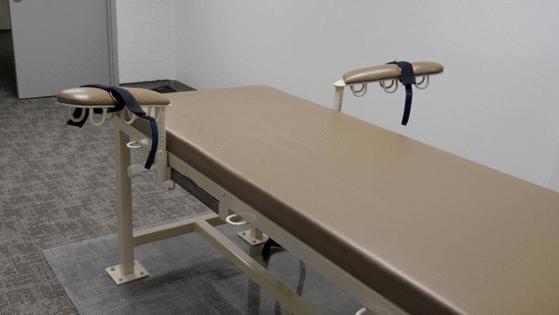Judge blocks Idaho executions until prison officials improve media access
Published in News & Features
BOISE, Idaho — A federal judge in Idaho halted all executions in the state, issuing a preliminary injunction Tuesday against carrying out the death penalty until the state prison system increases access for media witnesses to a concealed room where prison officials prepare for and perform a lethal injection.
U.S. Magistrate Judge Debora Grasham for the District of Idaho ruled that the Idaho Department of Correction must upgrade the wing of the maximum security prison where executions take place so members of the press can see and hear what happens before, during and after a prisoner is put to death. The state cannot pursue an execution until IDOC makes the improvements, she wrote.
“It is clear that the performance of capital punishment in the United States has historically been open to the public,” Grasham said in her 34-page decision. “The court finds that the means and methods of an execution were also open and obvious, allowing the public to witness not only the execution itself, but the cause and effect of the execution method used.”
Grasham’s ruling came in response to three news outlets, including the Idaho Statesman, suing IDOC over the right to hear and see what goes on in the so-called “medical team room,” where execution team members prepare and administer drugs for a lethal injection. The two other news outlets include The Associated Press and East Idaho News in Idaho Falls.
Earlier in the case, Grasham denied IDOC’s efforts to dismiss the lawsuit outright.
She rejected an argument that the matter in question, of restricting journalists from seeing and hearing the medical team room during an execution, did not reflect a free press issue in violation of the First Amendment. Grasham also brushed aside arguments from the state that the lawsuit was “speculative and hypothetical” because no death row prisoner is currently scheduled to be executed, and that the news outlets could not prove potential harm over IDOC’s policy.
The Idaho Attorney General’s Office represents IDOC in the legal matter. Neither IDOC nor the Attorney General’s Office immediately responded to requests for comment from the Statesman on Tuesday afternoon. The Attorney General’s Office has contracted with private attorney Tanner Smith of Boise-based law firm Moore Elia Kraft & Stacey for the case.
Smith contended during oral arguments that to grant the media’s request to hear and see what happens in the execution chamber preparation room would place an “undue burden” on the state for IDOC to add a camera and microphone to an existing closed-circuit broadcast system. Doing so also would constitute a judge ordering unprecedented access to a state’s execution process, Smith argued.
“It goes beyond what any court has ever done,” Smith told Grasham at the hearing.
Attorney Wendy Olson, a former U.S. attorney for Idaho and now a partner with Stoel Rives law firm, represents the three news outlets in the case. She repeatedly argued that media witnesses at an execution, representing the interests of the public, are entitled to see all activities “inextricably intertwined” with the state carrying out the death penalty. That includes when the execution team prepares and administers lethal injection drugs by depressing syringes into intravenous lines attached to the prisoner.
In court, Smith rebutted the assertion. He framed the action of pressing syringe plungers — which is out of sight of witnesses — to deliver execution drugs to the condemned prisoner as a “minute detail.”
“It’s a minute detail that the deadly drug is administered?” Grasham fired back. “I don’t see that as a minute detail. It’s inextricably intertwined.”
Smith later conceded that an execution by lethal injection cannot happen without prison officials pushing the drugs into the IV line connected to the condemned. But to grant journalists more visual and audio access to the process, he argued, still went beyond the scope of what media witnesses had a right to hear and see.
Idaho fails to execute Thomas Creech by IV line
Idaho last executed a prisoner more than a dozen years ago, when it lethally injected convicted murderer Richard Leavitt in June 2012. The state tried to execute its longest-serving death row prisoner, Thomas Creech, convicted of three murders in Idaho, in February 2024, but called off his planned lethal injection when prison officials could not find a suitable vein for an IV for almost an hour.
Creech, 74, has remained in limbo ever since. His attorneys with the legal nonprofit Federal Defender Services of Idaho have argued in federal court that a second attempt to execute their client would represent cruel and unusual punishment in violation of his Eighth Amendment rights. The judge issued a stay of execution for Creech, which remains in effect pending a ruling after a December hearing.
The Federal Defenders did not immediately respond Tuesday to a request for comment on Grasham’s order, which effectively blocks executions in Idaho until the prison system improves what media witnesses can hear and see in any future lethal injections. Another of the nonprofit’s clients, death row prisoner Gerald Pizzuto, 69, who is terminally ill with bladder cancer, also is under an active execution stay.
Following the state’s failure to execute Creech, the Republican-controlled Idaho Legislature passed a bill this year, which Republican Gov. Brad Little signed into law, to make a firing squad the state’s primary method to carry out the death penalty starting in July 2026. New IDOC Director Bree Derrick told a legislative committee in March that remodeling the execution chamber for the controversial method will take about nine months of construction.
None of the state’s 15 Democratic lawmakers voted in support of switching from lethal injection to a firing squad for Idaho executions.
Little’s office did not immediately respond to a request for comment Tuesday.
The renovation to accommodate a firing squad is expected to come with almost a $1 million price tag, IDOC previously told the Statesman. A design and building firm is rescoping the project in light of the new law to update the estimated cost and timeline, in preparation of construction, Derrick said.
“We are confident that we will be able to make that happen in advance of the July 1 effective date next year,” she told the committee.
This year, South Carolina became the first U.S. state to execute a prisoner by firing squad in nearly 15 years, having now done so twice since March. Utah, Missouri and Oklahoma are the three other states that allow shooting a prisoner to death, but only Idaho has made the method its preferred way to carry out the death penalty.
When Idaho’s new law takes effect next year, lethal injection will remain the state’s backup execution method.
_____
©2025 Idaho Statesman. Visit at idahostatesman.com. Distributed by Tribune Content Agency, LLC.







Comments